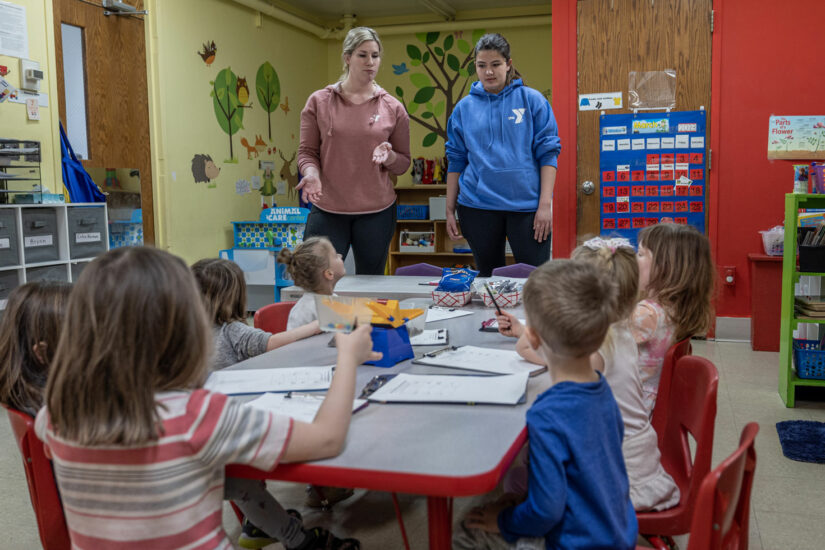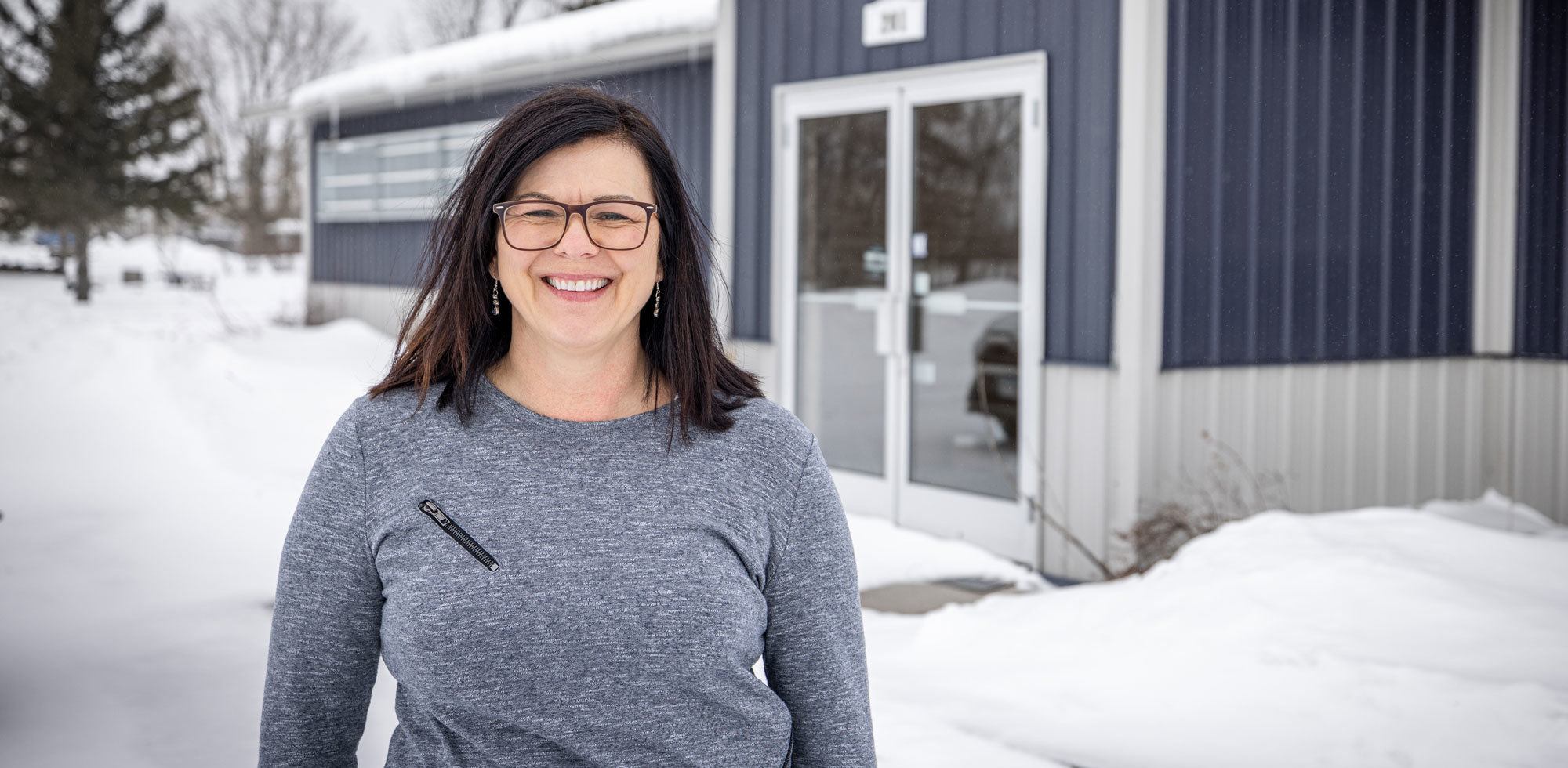
Front & Center: Child Care
Creativity and new community partnership are taking shape to solve Central Minnesota’s child care crisis
By Laura Billings Coleman | Photography by John Linn
Hackensack and other communities hit by home daycare closures have asked Morgan Dabill if the model for her smaller-than-average child care center could be more sustainable in outstate Minnesota. “It’s critical that I keep my focus on getting my business off the ground, but if it’s a model that works, we’ll keep using it.” Like any new business owner, Morgan Dabill had a lot on her mind in the lead-up to launching a new child care center in Pine River. After finding the perfect plot of land on the route between Pequot Lakes and Backus, Dabill spent months meeting with bank officers, fine-tuning her business plan, applying for grants, supervising the construction, and hiring and training staff certified to handle everything from infant care to after-school programs.
The one thing she didn’t have to worry about was attracting customers.
“As soon as word got out that we were even thinking about starting this up, I had people messaging me about finding a spot for their kids,” says Dabill. “Since the pandemic, I know of so many parents who’ve had to cut their hours or quit working completely because there’s no place for their kids to go. I’ve had families calling from 45 minutes away. You can feel how desperate they are.”
Since opening its doors in October 2022, the Wild Roots Early Learning Center is already in the black with more than 40 children in full-time care, a staff of nine caregivers, and more than a year-long waiting list for infant care. When fully enrolled, Dabill’s nature-focused operation will be able to accommodate nearly 70 kids from 6 weeks to 12 years old, dramatically improving child care options in an area hard hit by the recent closure of several family-based providers. But across much of Greater Minnesota, finding available child care slots remains an uphill battle for working families—and a growing headache for employers.
“What was already a deeply entrenched problem prior to the pandemic has, in fact, gotten worse—particularly in Central Minnesota, where there’s a forecasted shortfall of up to 17,000 child care slots to meet demand,” said Don Hickman, Initiative Foundation’s vice president for community and workforce development. Family-based providers have long been the backbone of the rural child care system. For the past 20 years, though, providers have been leaving the field at a far faster rate than they’ve been replaced. It’s happened for a host of reasons: from a predictable wave of Baby Boom retirements to the unexpected challenges of operating through the pandemic. While profit margins have always been low—providers need to make their rates affordable for working parents—Minnesota’s strong post-pandemic jobs recovery has added additional pressure as child care workers leave the field for richer opportunities.
“Many providers now have to wonder why they’re working 14-hour days and wearing down their homes while running a home child care when they could be making several dollars an hour more, with benefits, working at a gas station or a grocery store,” Hickman said. While expanding capacity in child care centers has helped to offset the closure of home-based options in higher-density areas, that’s not an option in most of Minnesota’s rural communities. “You typically need a mass of 80 children to make a child care center cash flow,” he said. “Smaller communities don’t have those numbers, so families are a hundred percent dependent on home-based providers.”
Quality, affordable child care can no longer be viewed as a short-term problem families need to solve. “This is an economic development challenge,” Hickman said. “The free market isn’t going to fix it on its own.

Communities Commit
Fortunately, a growing number of communities across the Initiative Foundation region are making inroads as they explore more sustainable solutions to the persistent shortage. “Several years ago, if you mentioned child care to a room full of employers, you’d hear crickets,” said Marnie Werner, vice president for research and operations at the Center for Rural Policy and Development. Werner is the author of a new report, Rural Child Care Solutions: From the Ground Up. “The child care issue is now converging with the retirement of Baby Boomers, and if there’s not enough child care in a community, you’ve got an increasingly smaller pool of workers to fight over.”
That trend is what motivated Mille Lacs Corporate Ventures to take the lead on creating a new child care center to serve young families in 30 new workforce housing units at Red Willow Estates in Onamia. “As we thought about how to tackle the child care problem in our region, we looked at the ways we could utilize our available buildings,” said Beth Gruber, director of planning and community engagement at Mille Lacs Corporate Ventures (MLCV). Working with Kidz Zone, a provider with centers in Garrison and Aitkin, MLCV recently earned a major grant from the Minnesota Department of Employment and Economic Development (DEED) to fast-track the development of a 63-slot child care center set to open in the fall of 2023. Partners at Mille Lacs Health System, eager to expand child care options for their growing workforce, will cater the food for the center, eliminating the need to install a commercial kitchen. “The Mille Lacs Band is the largest employer in this region, so this partnership will really help our workforce. At the same time, it will serve everyone in our community,” Gruber said.
That all-hands approach also is on display in Brainerd, where the YMCA recently earned $600,0000 in federal funding to help convert a former funeral home into a child care center for up to 140 kids. Even before the pandemic, Crow Wing County had a child care deficit of about 1,300 spots. It’s a shortage that has galvanized multiple partners to help fill the gap with grants from DEED, the Brainerd Lakes Area Community Foundation, Minnesota Main Street Economic Revitalization funds, and American Rescue Plan Act funding from Crow Wing County. Seeing business, government and philanthropy working together to solve the child care gap in Brainerd is an encouraging sign, says Werner. “Over the last 20 years I’ve been studying this, it’s clear that real community cooperation, getting everyone on board, is what contributes to long-term success,” she says. “This is too big a problem to expect just one sector to solve everything.”

The Initiative Foundation provided grants to support the Pine River, Onamia and Brainerd projects. It also has supported a host of other projects across the region as part of its long-standing commitment to improving and expanding early childhood options. The Foundation has also brokered a partnership with First Children’s Finance and Chisago, Pine, Mille Lacs and Isanti counties by offering each county a $10,000 challenge match to implement their best ideas for overcoming the child care gap.
Investing in the Profession
While increasing child care capacity across the region is critical, Hickman said, Central Minnesota will also need to activate a new generation of child care providers, especially those who can fill the growing gaps in family-based child care. “Lifting up home-based providers is critical to rural areas that don’t have big employers that can take the lead,” he said. “Home-based care is typically one-third cheaper than center-based care, and for these rural communities, having room for eight to 10 kids is right-sized.”
To encourage more people to enter the profession, or expand the capacity of their current child care businesses, the Initiative Foundation has contracted with St. Cloud Technical and Community College, Central Lakes College in Brainerd, and Pine Technical and Community College to make it possible for students to graduate debt-free while earning certifications and degrees in early child development and education. The Foundation also is exploring partnerships to expand the offering to the Leech Lake Tribal College, and to build credentialing pathways in both Spanish- and Somali-language programs.
“If students still need help after [they’ve been] awarded financial aid, the Initiative Foundation covers the rest,” said Annette Weaver, Pine Tech’s education coordinator. Weaver also leads the region’s professional development delivery initiative for Child Care Aware.
With virtual night-time classes, many early childhood education offerings have been retooled to fast-track workers sidelined by the pandemic into new jobs in child care, and to make continued certification simpler for working providers in rural areas. Since launching, the program has made it possible to graduate nearly 200 child care providers per semester, and to support continued certification paths for fledgling providers like Cora Collins, 28, who just launched a home-based child care in Brainerd after leaving a third-shift manufacturing job.
“This first year has been more of a challenge than I’d expected,” said Collins, who notes that making required safety updates to her home, and setting prices that are affordable for working families while remaining profitable, has been a challenge. “I love working with children, but financially, it doesn’t always make sense.”
That’s why experts believe a final piece of the child care puzzle will depend on finding new ways to ensure providers can improve upon the current average: $11 an hour and a 65-hour work week. “Even if they’re providing care because it’s something they value doing in their communities, we still need to think about family providers as small businesses that need support,” says Elizabeth Davis, professor of applied economics at the University of Minnesota. In Swift County, for instance, a child care grant program helps family providers cover ancillary expenses, up to $150 per enrolled child. Brown County dropped all licensing fees for family child care providers. Cook County has a child care assistance program that helps qualifying families pay for a portion of their child care costs, making care more accessible to families and rates more sustainable for providers.
Werner, for her part, also sees promise in the so-called “pod model,” which would allow multiple licensed family providers to use a single location, like a church, for serving small groups of kids outside of their home. Multiple studies show that the stress, isolation and wear and tear of having a business in the home is a serious pain point for potential family providers. “Pods are a way to get those businesses out of the home,” Werner said. “Women have so many more career options that the days when a young mother will decide to take in a few more kids while they’re home are coming to an end. The more we can do to help family providers run their day cares as profitable businesses, the more it’s going to have an effect.”